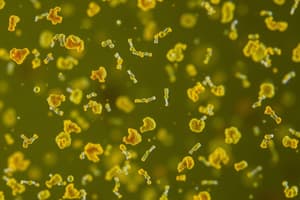Podcast
Questions and Answers
Which of the following is NOT a primary focus of microbiological analysis in food?
Which of the following is NOT a primary focus of microbiological analysis in food?
- Detecting microorganisms
- Identifying microorganisms
- Quantifying nutrient content (correct)
- Ensuring the presence of correct microbes during preparation
The presence of Streptobacillus lactis in cheese production indicates spoilage, rendering the product unsafe for consumption.
The presence of Streptobacillus lactis in cheese production indicates spoilage, rendering the product unsafe for consumption.
False (B)
Define 'intoxification' in the context of foodborne illnesses.
Define 'intoxification' in the context of foodborne illnesses.
Intoxification occurs when bacteria colonize a food source and produce a toxin, which leads to illness upon consumption.
A colony-forming unit (CFU) is a measure used to estimate the number of viable ______ cells in a sample.
A colony-forming unit (CFU) is a measure used to estimate the number of viable ______ cells in a sample.
Match each microorganism type with its defining characteristic.
Match each microorganism type with its defining characteristic.
Which pH classification best describes most microorganisms?
Which pH classification best describes most microorganisms?
Increasing acidity always promotes microbial growth in food systems.
Increasing acidity always promotes microbial growth in food systems.
Explain the significance of water activity in controlling microbial spoilage in food.
Explain the significance of water activity in controlling microbial spoilage in food.
Molds generally thrive in conditions with a pH ______ than 4.0.
Molds generally thrive in conditions with a pH ______ than 4.0.
Match each food preservation method with the growth factor it primarily controls.
Match each food preservation method with the growth factor it primarily controls.
Fruits and soft drinks are resistant to spoilage due to what main factor?
Fruits and soft drinks are resistant to spoilage due to what main factor?
Salinity and water activity are unrelated parameters when considering food preservation techniques.
Salinity and water activity are unrelated parameters when considering food preservation techniques.
Explain how temperature affects microbial growth, referencing specific classifications such as psychrophiles and thermophiles.
Explain how temperature affects microbial growth, referencing specific classifications such as psychrophiles and thermophiles.
Organisms that thrive between 50 °C and 64 °C are classified as ______.
Organisms that thrive between 50 °C and 64 °C are classified as ______.
Match each temperature range with the appropriate microbial classification.
Match each temperature range with the appropriate microbial classification.
Where do obligate aerobes concentrate in a thioglycollate broth?
Where do obligate aerobes concentrate in a thioglycollate broth?
Aerotolerant organisms are poisoned by oxygen and, therefore, exhibit growth only in the absence of oxygen.
Aerotolerant organisms are poisoned by oxygen and, therefore, exhibit growth only in the absence of oxygen.
Differentiate between obligate anaerobes and aerotolerant organisms in terms of oxygen requirements and tolerance.
Differentiate between obligate anaerobes and aerotolerant organisms in terms of oxygen requirements and tolerance.
[Blank] can grow with or without oxygen as they can metabolise energy aerobically or anaerobically.
[Blank] can grow with or without oxygen as they can metabolise energy aerobically or anaerobically.
Match each type of organism with its oxygen requirement/tolerance.
Match each type of organism with its oxygen requirement/tolerance.
Which of the following elements is NOT typically considered a primary nutritional requirement for microorganisms?
Which of the following elements is NOT typically considered a primary nutritional requirement for microorganisms?
Spoilage of acid foods (pH 4.6 or lower) is easily detectable through standard pH measurement alone.
Spoilage of acid foods (pH 4.6 or lower) is easily detectable through standard pH measurement alone.
Why is pH not always the best indicator for predicting microbial response in food preservation?
Why is pH not always the best indicator for predicting microbial response in food preservation?
The presence of ______ in milk produces lactic acid, contributing to increased acidity as the population grows.
The presence of ______ in milk produces lactic acid, contributing to increased acidity as the population grows.
Match the method to detect and identify microorganisms with its approach:
Match the method to detect and identify microorganisms with its approach:
Which method is used to detect specific genetic sequences of microorganisms?
Which method is used to detect specific genetic sequences of microorganisms?
Defined media use 'undefined' components such as yeast extract or tryptone.
Defined media use 'undefined' components such as yeast extract or tryptone.
Describe the difference between selective and differential media. Give an example of each.
Describe the difference between selective and differential media. Give an example of each.
The process of growing organisms on a suitable medium at different dilutions to estimate their population size is known as ______.
The process of growing organisms on a suitable medium at different dilutions to estimate their population size is known as ______.
Match the type of culture media with its primary characteristic:
Match the type of culture media with its primary characteristic:
What is the main purpose of biochemical testing in microbiology?
What is the main purpose of biochemical testing in microbiology?
A high concentration of colonies on a petri dish always results in an accurate enumeration of the microbial population.
A high concentration of colonies on a petri dish always results in an accurate enumeration of the microbial population.
Explain the assumption behind counting colony-forming units (CFU) on an agar plate.
Explain the assumption behind counting colony-forming units (CFU) on an agar plate.
The abbreviation IMVIC stands for Indole, Methyl Red, Voges-Proskauer, and ______ utilization, which are a series of biochemical tests used to identify bacteria.
The abbreviation IMVIC stands for Indole, Methyl Red, Voges-Proskauer, and ______ utilization, which are a series of biochemical tests used to identify bacteria.
Match the foodborne illness with its cause:
Match the foodborne illness with its cause:
What is the initial step in detecting acid food spoilage?
What is the initial step in detecting acid food spoilage?
Molecular biology identification utilizes a unique molecular marker of the microorganism.
Molecular biology identification utilizes a unique molecular marker of the microorganism.
Describe the process of detecting the number of microorganisms in a sample.
Describe the process of detecting the number of microorganisms in a sample.
Molecular biology identification makes use of the ______ of the microorganism.
Molecular biology identification makes use of the ______ of the microorganism.
Match the definition with the description:
Match the definition with the description:
Flashcards
What is microbiological analysis?
What is microbiological analysis?
Detection/identification of microorganisms vital in food analysis.
What indicates food spoilage?
What indicates food spoilage?
Microbes present in acceptable levels. If not, spoilage may occur.
What is infection?
What is infection?
Bacteria colonize the gut and cause illness.
What is intoxication?
What is intoxication?
Signup and view all the flashcards
What is intoxification?
What is intoxification?
Signup and view all the flashcards
What are bacteria?
What are bacteria?
Signup and view all the flashcards
What is yeast?
What is yeast?
Signup and view all the flashcards
What is mold?
What is mold?
Signup and view all the flashcards
What is a virus?
What is a virus?
Signup and view all the flashcards
What are parasites?
What are parasites?
Signup and view all the flashcards
What are neutrophiles?
What are neutrophiles?
Signup and view all the flashcards
What effect does acidity have?
What effect does acidity have?
Signup and view all the flashcards
What microbes are important acidophiles?
What microbes are important acidophiles?
Signup and view all the flashcards
How do organic acids minimize spoilage?
How do organic acids minimize spoilage?
Signup and view all the flashcards
How does controlling water activity preserve food?
How does controlling water activity preserve food?
Signup and view all the flashcards
How does salinity preserve food?
How does salinity preserve food?
Signup and view all the flashcards
How does temperature affect food preservation?
How does temperature affect food preservation?
Signup and view all the flashcards
Can atmosphere serve as a growth factor?
Can atmosphere serve as a growth factor?
Signup and view all the flashcards
What are the key nutrients for microorganisms?
What are the key nutrients for microorganisms?
Signup and view all the flashcards
Why isn't pH a perfect indicator for predicting microbial response?
Why isn't pH a perfect indicator for predicting microbial response?
Signup and view all the flashcards
What problems can microorganisms cause in food?
What problems can microorganisms cause in food?
Signup and view all the flashcards
How can microorganisms be helpful in food?
How can microorganisms be helpful in food?
Signup and view all the flashcards
Besides culturing, what other approaches are used to detect/identify?
Besides culturing, what other approaches are used to detect/identify?
Signup and view all the flashcards
What are defined media?
What are defined media?
Signup and view all the flashcards
What are complex media?
What are complex media?
Signup and view all the flashcards
What are selective media?
What are selective media?
Signup and view all the flashcards
What are differential media?
What are differential media?
Signup and view all the flashcards
How does biochemical testing work?
How does biochemical testing work?
Signup and view all the flashcards
How is colony growth expressed?
How is colony growth expressed?
Signup and view all the flashcards
What are obligate aerobes?
What are obligate aerobes?
Signup and view all the flashcards
What are obligate anaerobes?
What are obligate anaerobes?
Signup and view all the flashcards
What are facultative anaerobes?
What are facultative anaerobes?
Signup and view all the flashcards
What are microaerophiles?
What are microaerophiles?
Signup and view all the flashcards
What are aerotolerant organisms?
What are aerotolerant organisms?
Signup and view all the flashcards
What are Mesophiles?
What are Mesophiles?
Signup and view all the flashcards
What are Thermophiles?
What are Thermophiles?
Signup and view all the flashcards
What are Psychrotrophs?
What are Psychrotrophs?
Signup and view all the flashcards
What are Psychrophiles?
What are Psychrophiles?
Signup and view all the flashcards
What are Extreme Thermophiles?
What are Extreme Thermophiles?
Signup and view all the flashcards
Study Notes
Introduction to Microorganisms in Food
- Microbiological analysis involves detecting and identifying microorganisms as a crucial part of food analysis.
- Addressing whether the correct microbes are present is important during food preparation, for example:
- Streptobacillus lactis in cheese production.
- Acetobacter in vinegar production.
- Assessing whether microbes are at acceptable levels is important for food spoilage, for example:
- Lactobacillus in milk at 2 x 10^5 CFUs/mL.
- E. coli in bean sprouts at 5 x 10^3 CFUs/g, where CFU stands for colony-forming unit.
- Microbes impact a food's shelf-life.
- Controlling microbial growth helps prolong a food's shelf-life.
- Food-borne illnesses can occur through:
- Infection, when bacteria colonize the gut.
- Intoxication, when bacteria produce a toxin.
- Intoxification, when bacteria colonize and produce a toxin.
Types of Microorganisms
- Bacteria: Single-celled prokaryotes, such as Lactobacillus or certain E. coli strains found in foodborne illnesses.
- Yeast: Single-celled eukaryotes like Saccharomyces species, used to make beer or wine.
- Mold: A structure formed by some fungi; Penicillum is an example.
- Virus: An infectious agent replicating in other organisms, like Norovirus spreading through foods/surfaces.
- Parasites: Animals or protozoa such as Giardia.
Growth Requirements of Microorganisms
- Most microorganisms are neutrophiles, thriving in neutral pH conditions.
- Acidity has an inhibitory effect on microbial growth.
- Bacteria grow at pH > 4.5 (at aw of 0.85).
- Yeasts grow at pH > 4.0 – 4.5.
- Molds grow at pH < 4.0.
- Acidophiles include molds, yeasts, and lactic acid bacteria.
- Organic acids, indicated by low pH, help minimize food spoilage.
- Water activity influences microbial growth.
- Salinity and water activity are inter-related.
Temperature and Microorganism Growth
- Psychrophiles: "Cold-loving" organisms that grow from -20 °C to 20 °C.
- Psychrotrophs: Cold-tolerant organisms that grow at 0 °C but prefer 20 °C – 40 °C.
- Mesophiles: Thrive in an optimum growth range of 20 °C – 45 °C.
- Used in making fermentation products.
- Most human pathogens are mesophiles.
- Thermophiles: "Heat-loving" organisms that thrive between 50 °C and 64 °C.
- Extreme Thermophiles: Thrive between 65 °C and 79 °C.
Atmosphere
Bacteria Identification by Oxygen Requirements
- Aerobic and anaerobic bacteria can be identified by growing them in test tubes of thioglycollate broth.
- Obligate aerobes: Require oxygen.
- Gather at the top of the tube where oxygen concentration is highest.
- Obligate anaerobes: Poisoned by oxygen.
- Gather at the bottom of the tube where the oxygen concentration is lowest.
- Facultative anaerobes: Grow with or without oxygen.
- They gather mostly at the top because aerobic respiration generates more ATP.
- Microaerophiles: Need oxygen but are poisoned by high concentrations.
- They gather in the upper part of the test tube.
- Aerotolerant organisms: Do not require oxygen.
- Not poisoned by oxygen and are evenly spread throughout the test tube.
Nutrients
- Microorganisms need specific nutrients.
- These include sources of carbon, nitrogen, sulfur, and phosphorous.
Growth Factors and Food Preservation
- pH: Acidifying foods with organic acids or acid-producing microorganisms.
- Lowers the pH of canned goods.
- Water activity: Storing food with water activity < 80 prevents microorganism growth.
- Salinity: Salting foods prevents the growth of microorganisms.
- Temperature: Heating foods removes bacteria via pasteurization and cooking.
- Storing food in cold conditions and following maximum holding times at room temperature also control growth.
- Atmosphere: Reduce growth of food spoilage organisms in canned goods.
- Achieved by limiting oxygen.
- Nutritional requirements: Foods with good nutritional value need to be controlled using the above growth factors.
Spoilage of Acid Foods
- Must be detected by culturing with acidified media (pH 5.0 – 5.5).
- pH isn't the best indicator for predicting microbial response for preservation, as it doesn't indicate:
- Changes in total acidity (buffering effects).
- The type of organic acid produced.
- Problematic microorganisms in food lead to food spoilage and illness (food pathogens).
- Some microorganisms, like bacteria or fungi in fermented food, are helpful.
- Controlling microorganism growth requires understanding growth requirements.
Detecting, Identifying, and Counting Microorganisms
- Food microbiologists need to understand what microorganisms are present in a system.
- Food requires storage conditions that prevent growth.
- Preservation methods may remove multiple growth factors for different organisms.
- Approaches to identifying microorganisms in food:
- Culturing or growing.
- Molecular biology testing for genetic markers.
- Testing for specific immunological markers.
- Specific purpose tests.
Culture Methods
- Grow organisms on media in a petri dish using the traditional approach.
- Different organisms have different growth requirements.
- Pathogenic organisms tend to be more fastidious than nonpathogens.
- Different medias detect different organisms.
- Defined media: all components are known.
- Complex media: involves "undefined" components such as yeast extract.
- Selective media: only selective bacteria can grow.
- Differential media: most bacteria will grow, but it can distinguish certain characteristics.
Biochemical Testing
- Organisms have biochemical reactions.
- These assist in categorization and identification.
- Examples: Gelatinase, IMViC, and lactose fermentation.
Enumerating
- Grow organisms in a suitable medium at different dilutions.
- Get separate colonies and a countable number on the plate.
- Number is expressed as cfu (colony-forming units).
- There is an assumption of each colony arising from a single bacteria.
Molecular Biology
- Utilizes microorganism DNA.
- Probes for a specific and unique part of the genome.
- Can be done in a few hours.
- Can provide very good specific identification.
Immunological
- Utilizes a unique molecular marker of the microorganism.
- Requires an antibody to that marker.
Other Methods
- Quick measure of a characteristic related to microbial activity.
- Titratable acidity (TA) in milk.
- Lactobacillus in milk produces lactic acid.
- Low bacteria levels result in low acidity, mostly due to lactic acid.
- As population increases, acidity increases.
Studying That Suits You
Use AI to generate personalized quizzes and flashcards to suit your learning preferences.




